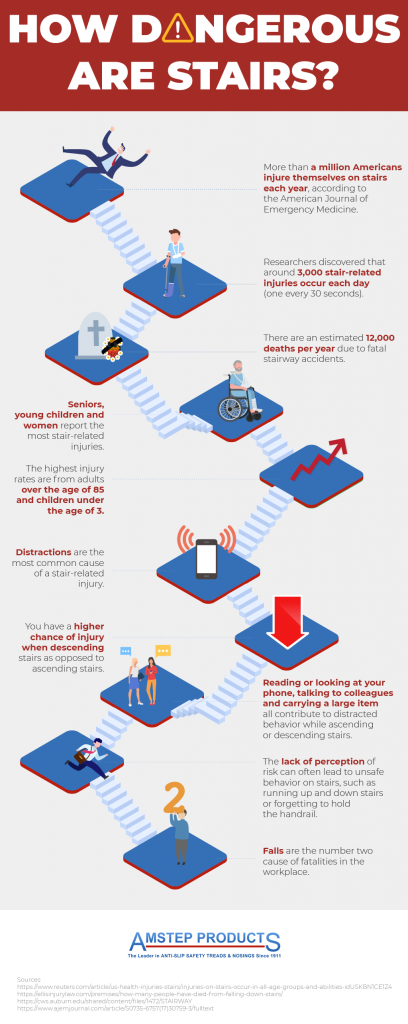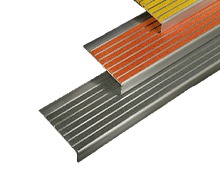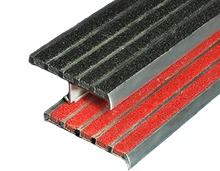What Are Stair Treads
May 17, 2019Non-Slip Stairs for Restaurants
May 20, 2022Whether at work, at home or out in public, falling down the stairs is a significant worry for many people. As an accident that can result in life-changing injuries, it’s important to know how you can prevent these from happening as soon as possible.
Stairway safety should always be at the forefront of your mind every time you use stairs. Stair safety products, such as handrails, non-slip stair treads, stair nosing, and anti-slip coatings, provide users with the peace of mind that the environment is as safe as possible from the get-go.
If you’re looking for invaluable guidance around how stair related accidents occur, where they can occur, common injuries related to it, how to recover and how to improve safety, read on to find out more.
Accident Statistics Related to Falling Down Stairs
 Stair accident statistics are some of the highest injuries listed each year – both in the USA and abroad. In a 2017 study written in The American Journal of Emergency Medicine, it was found that every year, there is an average of over one million injuries that come as a result of falling down the stairs. As the second leading cause of accidental injury in the country, it’s a statistic that can’t be ignored.
Stair accident statistics are some of the highest injuries listed each year – both in the USA and abroad. In a 2017 study written in The American Journal of Emergency Medicine, it was found that every year, there is an average of over one million injuries that come as a result of falling down the stairs. As the second leading cause of accidental injury in the country, it’s a statistic that can’t be ignored.
Reviewing falling down stairs injury statistics uncovers even scarier information: every year there is an average of 12,000 deaths as a result of a stairway accident. Showcasing just how dangerous stairs can be in every environment, it indicates the importance of following the correct practices.
Interestingly, many believe that it’s only older individuals that primarily fall down the stairs. And although a high portion of those in the study were older adults, the highest statistic (67.2%) found that it was a combination of these people, along with younger children.
Common Injuries from Falling Down Stairs
So you might be wondering – what are the most common injuries from falling down stairs? And although every person might have a different injury as the result of a fall, there are several in particular that are more prevalent than others. These typically include the following:
- Sprains and strains (32.3% according to the above study)
- Fractures (19.3%) – such as to the face, hands and wrists
- Spinal cord damage
- Deep lacerations
- Head and neck injuries (21.6%)
- Injury to the brain
- Injuries to the back or neck
- Broken bones
- Internal bleeding
- Lower extremity injuries (e.g dislocations or organ damage)
The severity of the injury will, of course, also depend on the type of staircase that’s involved (e.g whether it’s carpeted or not) and the way in which you fell. For example, you could fall forwards leading to you applying your weight to your arm or you could fall backwards, resulting in you hitting your head on the above steps with force.
Stair Safety at Work
Stair safety at work should be a top priority for employers. Accidents can happen at any time and to anyone – so it’s vital that the right steps are taken to prevent this from happening. Accidents can occur by someone missing their step or slipping on the step that’s there if it’s not properly protected.
Whether this is caused by stairway construction or a particular defect (i.e uneven tread or a missing banister) will depend on the staircase in question. It would be unfortunate to find one of your employees or yourself injured because of poor construction or lack of protective parts.
OSHA Stair Safety
When employers are looking to install a stairway in their workplace, it’s a good idea to look at the OSHA stair safety regulations. These detailed regulations lay out exact requirements that an employer should follow.
From ensuring that there are handrails provided on each staircase to guaranteeing that each stairway platform and landing is at least 30 inches in depth, it will help to create stairs that are safe for all your employees.
OSHA regulations should be adhered to across all types of work environments – from industrial buildings to recreational facilities and marine buildings – and utilized in conjunction with any other building codes and stair compliance that may apply.
Stair Safety at Home
As well as in a work environment, it’s vital that stair safety is practiced within the home. Accidents from falling down stairs can happen any time at home. And if you don’t live with anyone or you fall when no one else is home, you could find yourself in serious danger.
Therefore, as well as making physical changes to your staircase to ensure that it’s safer overall, it’s critical that you follow the right safety practices when you use it. For example, you could:
- Ensure that you’re staying alert when you’re on the stairs (e.g not being distracted while using them)
- You remove any trip hazards
- Walk slowly up the stairs (avoid running or skipping steps)
- Tread carefully
Stairway safety shouldn’t only be practiced by you, but others in your family to try and ensure that any accidents are prevented. It only takes a split second for one to happen. So limit this risk as much as you possibly can.
How to Recover from a Fall Down the Stairs
If an accident occurs, it’s worth knowing how to recover from a fall down the stairs. All of the above injuries mentioned are incredibly significant – leading the person to seek medical treatment in most cases.
The recovery period for minor incidents typically involves allowing the injured muscles, bones, or joints to rest. Hot or cold compresses might be suggested to help with pain and bruising. In order to receive the proper care you need to recover from a stair related injury, it is advised that you see a doctor or healthcare professional.
The medical treatment suggested by your physician could include a hospital procedure, emergency care, long-term rehabilitative therapy or home help – in the most severe cases. Of course, this will depend on how extreme the injury is, but it’s good to know the type of medical attention you might face if an accident does occur.
Top Prevention and Safety Tips
So how can you help to prevent these injuries from occurring? Well, alongside following the above safety practices, you could take proactive steps such as installing Amstep stair treads or stair nosing.
Amstep Stair Treads
 Our non-slip stair treads are designed to minimize the risk of slips and falls on stairs. Available in a range of different colors and sizes, you’ll be able to find treads that fit your application requirements to a tee.
Our non-slip stair treads are designed to minimize the risk of slips and falls on stairs. Available in a range of different colors and sizes, you’ll be able to find treads that fit your application requirements to a tee.
Created with aircraft-grade aluminum and an abrasive particle compound, these heavy duty treats are suitable for both indoor and outdoor purposes.
Striving to make your home or workplace a safer environment for everyone, these stair treads are fitted on the area of the staircase where your foot will make contact. With a range of color options available and options such as Glowline and Sightline, safety isn’t the only benefit you can reap from installing them.
Amstep Stair Nosing
 Alternatively, you could use Amstep stair nosing. As a requirement for many buildings (whether it’s industrial, commercial or municipal), this heavy-duty feature also works to make a stairway safer for all that use it. And due to our product’s design, it’s aesthetically pleasing as well as practical.
Alternatively, you could use Amstep stair nosing. As a requirement for many buildings (whether it’s industrial, commercial or municipal), this heavy-duty feature also works to make a stairway safer for all that use it. And due to our product’s design, it’s aesthetically pleasing as well as practical.
At Amstep, we have several products to choose from, ranging in color, size and application – giving you freedom to select which one suits your requirements best. Whether you’re anchoring concrete stair nosing or mounting over existing parts, we have products to fit your project’s needs. And with 8 different colors plus a glow-in-the-dark option, each step will be easier to see when ascending or descending stairs – making it far safer than ordinary treads and nosing that may blend into the color of the steps.
In Conclusion
We hope this guide has helped to show you the most common injuries that can happen as a result of falling down stairs, what the legislation states, how to recover from a fall and most importantly, and how to prevent this type of injury from occurring.
No matter whether you’re looking to enhance the safety of your home, a public place, or a workplace, it’s important to adhere to safety guidelines and enhance the safety of your staircases with products such as treads, nosings, and non-slip coatings.
Don’t allow yourself and others to be at risk of injury because the safety of your stairway was compromised.
